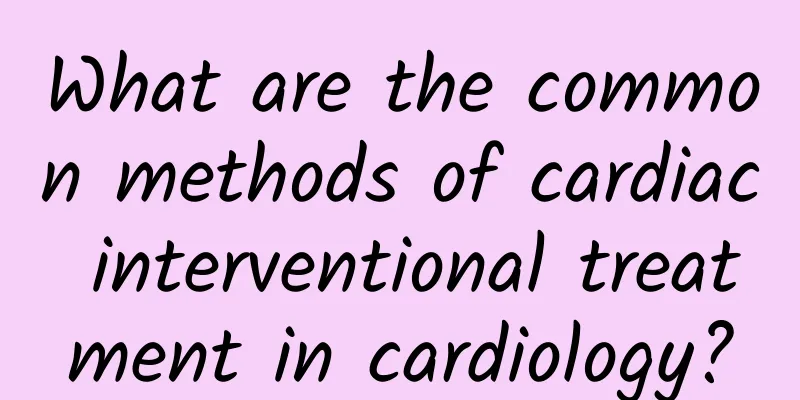What are the common methods of cardiac interventional treatment in cardiology?

|
Cardiology interventional therapy is one of the important means of diagnosing and treating cardiovascular diseases. These technologies provide patients with safer and more effective treatment options by diagnosing and intervening on the heart and blood vessels in a non-surgical way. This article will introduce the common methods of cardiology interventional therapy, including coronary angiography, percutaneous coronary intervention, and pacemaker implantation. 1. Overview of Cardiac Interventional Therapy Technology in Cardiology Department Cardiology interventional therapy is a new method for diagnosing and treating cardiovascular diseases. It does not require thoracotomy. Under the guidance of imaging methods, the catheter is sent to the lesion site by puncturing the surface blood vessels of the body with the help of certain instruments, and the heart disease is diagnosed and treated through specific cardiac catheter operation techniques. Cardiology interventional therapy includes a variety of specific methods, such as coronary angiography, PTCA + stenting, mitral valve balloon dilatation, radiofrequency ablation, pacemaker implantation, congenital heart disease interventional treatment, intracoronary thrombolysis, etc. These methods are all interventional means to diagnose and treat the heart or cardiovascular system, with the advantages of less trauma, low reaction, and fast recovery. It should be noted that cardiology interventional therapy is a relatively complex and high-risk treatment method, which needs to be performed by experienced doctors in professional medical institutions. Patients should fully understand the risks and effects of treatment before receiving treatment, and fully communicate and discuss with their doctors to make the right decision. 2. Common methods of cardiac interventional treatment in cardiology 1. Percutaneous Coronary Intervention Percutaneous coronary intervention (PCI) is a technique that uses a catheter to enter the coronary artery to dilate or implant stents in narrowed or blocked blood vessels to improve myocardial blood supply and relieve angina symptoms. It is currently one of the most commonly used and mature interventional techniques for the treatment of coronary heart disease. During percutaneous coronary intervention, doctors usually use imaging equipment such as X-rays or ultrasound to guide the catheter into the coronary artery. Then, contrast agents are injected through the catheter to show the morphology and structure of the coronary artery. If narrowed or blocked blood vessels are found, doctors may use balloons to dilate the blood vessels, or implant stents to restore blood flow. In recent years, new technologies such as drug-eluting balloons and bioresorbable stents have also been used in clinical practice, providing more options for the treatment of coronary heart disease. 2. Radiofrequency ablation Radiofrequency ablation is a technique that uses a catheter to send radiofrequency energy to destroy abnormal tissue that causes tachyarrhythmias to treat various tachyarrhythmias. Atrial fibrillation is one of the most common tachyarrhythmias. During radiofrequency ablation, doctors insert a catheter into the heart chambers and send radiofrequency energy to destroy abnormal tissue that causes the arrhythmia. This method can effectively treat atrial fibrillation and other tachyarrhythmias and improve patients' quality of life and prognosis. 3. Implantation of implantable cardiac pacemaker Implantable pacemaker implantation is a technique for treating bradyarrhythmias. During surgery, the doctor implants the pacemaker into the subcutaneous tissue of the patient's chest and then connects it to the atria or ventricles of the heart through wires to stimulate the heart and maintain normal heart rhythm. Implantable pacemaker implantation can be used to treat various bradyarrhythmias, such as sick sinus syndrome and high-degree atrioventricular block. In addition, cardiac resynchronization therapy is also a commonly used technique to treat conditions such as heart failure and heart enlargement by implanting a cardioverter defibrillator. 3. Advantages of Cardiac Interventional Therapy Technology in Cardiology Department 1. Security Cardiology interventional therapy technology has significant advantages in terms of safety. Through catheter or other minimally invasive means, the large incision required for traditional open-chest surgery is avoided, thereby reducing surgical trauma and postoperative pain. This minimally invasive surgical method not only reduces the patient's pain, but also reduces the risk of complications such as infection. In addition, interventional therapy technology can more accurately locate the lesion through precise catheter operation, avoid damage to surrounding tissues, and further reduce the difficulty of postoperative recovery. 2. Effectiveness Cardiology's cardiac interventional treatment technology has significant advantages in terms of effectiveness. It is not limited to the treatment of coronary heart disease, but can also be applied to a variety of cardiovascular diseases such as arrhythmia, cardiomyopathy, and valvular disease. PCI can quickly restore coronary blood flow, improve the patient's quality of life, and has stable long-term effects, reducing the risk of restenosis and reinfarction, and prolonging life. Therefore, this technology provides a safe and effective treatment option for patients with cardiovascular disease. 3. Security Cardiology interventional therapy technology has significant advantages in terms of minimal invasiveness. This technology is usually performed using tiny punctures or incisions that are much smaller than traditional surgical incisions, thereby reducing surgical trauma and postoperative pain. Since interventional therapy technology does not require large-scale tissue cutting and suturing, postoperative pain is less severe, and patients are able to resume daily activities faster, shorten hospital stays, and return to normal life faster. This minimally invasive surgical method not only reduces the patient's pain, but also helps improve the patient's quality of life after surgery. Summarize Cardiology's cardiac interventional therapy technology is one of the important means in the field of cardiovascular disease treatment, including a variety of common methods. Among them, percutaneous coronary intervention (PCI) is one of the most commonly used methods, which uses a catheter to perform balloon dilatation and stent implantation in the coronary artery to restore coronary blood flow and relieve angina symptoms. In addition, pacemaker implantation is also a commonly used interventional treatment method for the treatment of arrhythmias, bradycardia and other heart problems. In addition, cardiology's cardiac interventional therapy technology also includes cardiac radiofrequency ablation, congenital heart disease interventional treatment and other methods. These methods are minimally invasive, safe and effective, providing better treatment options for patients with cardiovascular diseases and improving patients' quality of life. |
<<: What are the early symptoms of esophageal cancer and gastric cancer?
>>: Traditional Chinese Medicine Rehabilitation Nursing—Gourd Umbilical Moxibustion
Recommend
Symptoms of internal heat in women
Summer is a season when it is easy to get angry. ...
Reasons for menstruation four days early
Some people say that menstruation is a woman’s go...
What does female external reproduction include?
What does female external reproduction include? M...
What kind of tea is Pu'er tea? Can Pu'er tea still be drunk after 10 years?
Pu'er tea is produced in Xishuangbanna, Linca...
What is the hemoglobin index of different buckwheat products? What is the recommended daily intake?
What is the glycemic index of different buckwheat...
When is the best time to get an IUD?
After years of clinical medical practice, it has ...
Is bleeding after taking birth control pills considered menstruation?
Emergency contraception is a kind of medicine use...
[Medical Q&A] Can patients with dentures undergo MRI examinations?
Planner: Chinese Medical Association Reviewer: Wa...
Can you eat loquat when you have a cold? What are the benefits of loquat?
As we mentioned earlier, loquats are rich in vitam...
Is there any case of cervical dilation without pain?
When a woman is about to give birth, the cervix w...
How long after the IUD is removed will it be easy to get pregnant?
Nowadays, with the promotion of family planning, ...
What color is normal for menstrual period?
The health of a woman's body can be judged ba...
White spots on nipples and repeated milk blockage
After a mother gives birth, she usually breastfee...
I heard that "the end of the ski slope is the orthopedic department"? Skiing should be done according to your ability!
Everyone Have you skied this year? Since Beijing ...









